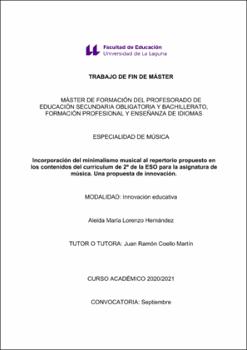Incorporación del minimalismo musical al repertorio propuesto en los contenidos del curriculum de 2º de la ESO para la asignatura de música. Una propuesta de innovación.
Fecha
2022Resumen
Durante las siguientes páginas expondremos dos situaciones a lasqueseenfrenta la asignatura de música en la Educación Secundaria Obligatoria. Detectamos en ella dos puntos, objetos de mejora y revisión. Uno deellos, laescasa oferta de repertorio que se ofrece al alumnado, estando esta centralizadaenla música académica, Centroeuropea de los siglos XVII a XIX, estilos mayoritariosBarroco, Romanticismo y Clasicismo. Entendemos que esta oferta, si bienválidaynecesaria, queda incompleta y muy alejada del universo del estudiante, por loqueproponemos una ampliación, acercando el espectro musical a su contemporaneidad. En segundo lugar, encontramos la escasa e incluso inexistente acciónmusical, es decir, la práctica de la propia música que en la realidad de las aulas quedaenunsegundo plano, olvidada e inutilizada frente a la carga teórica. Siendo la músicaunarte sonoro que se crea en un espacio y tiempo concreto y cuyo aprendizajeyentendimiento conlleva intrínsecamente la práctica, vemos, en la no realizacióndelamisma, una incoherencia. Estas reflexiones han llevado a la autora a llevar a la práctica una experienciadurante el periodo de prácticas realizado en el Máster en Formación del Profesoradode Educación Secundaria Obligatoria y Bachillerato, Formación Profesional yEnseñanza de Idiomas, en la cual, se ha pretendido, en un breve espacio detiempo, acercar la música del S. XX al alumnado y trabajar de forma totalmenteprácticayexperiencial con el estilo minimalista, al considerar a este, por sus características,
ideal para el trabajo en el aula During the following pages we will expose two situations that the subject of musicfaces during Secondary Education. We detect in it two points, objects of improvement and revision. One of them, thelimited range of repertoire offered to students, being centralized in academicmusic, Central European from the 17th to 19th centuries, the majority styles Baroque, Romanticism and Classicism. We understand that this offer, although validandnecessary, is incomplete and far removed from the student's universe, sowepropose an extension, bringing the musical spectrum closer to its contemporaneity. Secondly, we find the scarce and even non-existent musical action, that is, thepractice of one's own music that in the reality of the classrooms remainsinthebackground, forgotten and rendered useless in the face of the theoretical load. Sincemusic is a sound art that is created in a specific space and time and whoselearningand understanding intrinsically entails practice, we see, in the non-realizationof it, anincoherence. These reflections have led the author to put into practice an experienceduringthe internship period carried out in the Master's Degree in Teacher TrainingforCompulsory Secondary Education and Baccalaureate, Vocational TrainingandLanguage Teaching, in which, it has been claimed, in A short space of time, bringthemusic of the 20th century closer to the students and work in a totally practical andexperiential way with the minimalist style, considering it, due to its characteristics,
ideal for work in the classroom.





